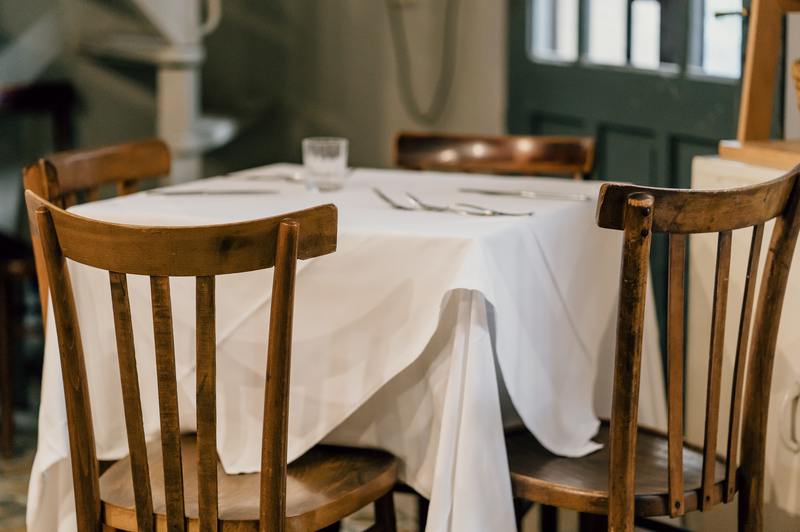It is a definite head-scratcher when mold gets on your tablecloth. So, it would help if you learned tips on how to get mold out of polyester tablecloths.
Most people leave their dining table plain, as they use it every day for eating meals. However, when occasions come to date, dressing up your table is a staple for a big day.

Imagine having a hectic schedule, to begin with, and then your tablecloth gets ruined by mold. Conveniently, we have scoured the best techniques to remove mold out of tablecloths made from polyester.
Cotton Vs. Polyester
Cotton is a soft, natural, hypoallergenic fabric that is most popularly used in infant clothing and bedding. Cotton has an 8.5% regain on moisture depending on humidity conditions.
On the other hand, polyester fabric is known for being hydrophobic. Polyester fiber does not absorb moisture or perspiration, which makes it a workhorse of gym clothes.
Polyester is synthetic, long-lasting, and durable. While many other fabrics develop fluff texture on the surface, polyester can withstand frequent washing.
Cotton can be more susceptible to mold because it has a higher absorption rate than polyester. Meanwhile, polyester can still grow these invasive fungi if left wet for at least twenty-four hours or exposed to a high humidity environment.
What Gets Out Mold Off Polyester Fabric?
When airflow is limited, mold infestation is an apparent problem at hand. Basements aren’t the only place mold can thrive.
Sufficient factors to grow mold are humidity, hot weather, and a dark environment. Here are some non-toxic products you can use to get rid of mold off your polyester:
Lemon
Lemon juice is used as a popular daily cleaner. Its 5% acidity is excellent for eliminating mold.
Lemon is excellent for porous materials such as table linen. Apply the sliced lemon directly onto the fabric or put it in a spray bottle.
Mold stain remover
Store-bought cleaners are the heroes for this matter. Mold stain remover items have two main ingredients: sodium hypochlorite and hydrogen peroxide.
White vinegar
White vinegar’s acidity content is at 5%, which makes it practical for mold cleanups. Use it at full strength, and let the vinegar sit on the fabric for at least 1 hour.
5 Steps Of Mold Cleanup On Polyester Tablecloths
Step #1. Check the label tag
From small to big clothing brands, they provide care instructions for their products. Following the cleaning procedures on the tablecloth’s label will let you know how to care for it properly.
It is recommended not to wash it in hot water to preserve the integrity of polyester linen. Instead, use warm water to prevent the stretchy material from wear and tear situations.
Step #2. Scrub the mold off
If you have a mold stain remover with hydrogen peroxide ingredients, spray it onto the tablecloth. Let it sit for about ten minutes and bring out your boar-bristle brush.
Scrub the mold stains gently until it somewhat disappears. Some stains are difficult to remove due to serious mold.
This goes for other mold cleaning agents as well. Whether you are using distilled white vinegar or lemon concentrates, scrub the mold right after applying the reactant.
Step #3. Pre-wash the tablecloth
Do not throw the table linen in the washer just yet. Make sure to pre-soak the fabric in water dissolved with commercial-grade detergent.
Leave it there for a couple of hours, and tough stains should soften through the process. Since you deal with musty tablecloths, pre-washing will help.
Pre-washing soiled clothes or sheets can make a difference as it cleans the garments thoroughly.
Step #4. Use lukewarm water
Polyester is a durable fabric, but hot water can cause shrinkage. Experts recommend using lukewarm water that’s between 98 and 105 degrees Fahrenheit.
As polyester is widely manufactured and retailed, there is no particular precaution about washing it. You can even machine-wash it in a normal cycle with mild detergent.
You can wash the mold-soiled polyester tablecloth in cold water, but it is not as effective in removing stains compared to warm water usage.
Step #5. Hang dry in the sun
All mold disappeared with a lot of hard work and scrubbing stains. The last step is to let it sundry out in the open.
The whole logic in this step is to let other mold spores residing in the material go away. This prevents allergic reactions in the future.
Care Tips For Polyester Fabric
Any fabric is susceptible to mold, even if a master tailor manually spun it. All you need to do is keep the polyester fabric away from damp, dark, and humid places, and you’re all set.
Check out these articles on how to treat sooty mold and how to write a mold report if you want to know more about mold.
Conclusion
Tablecloths protect the table from scratches and stains. It can be ornamental designs as well, especially when you have fancy celebrations coming.
However, mold stains are tough and are anything but easy to remove from tablecloths. Using your tools and homemade cleaning solutions, you don’t have to spend another dime on professional help — just read this article on how to get mold out of polyester tablecloths.
